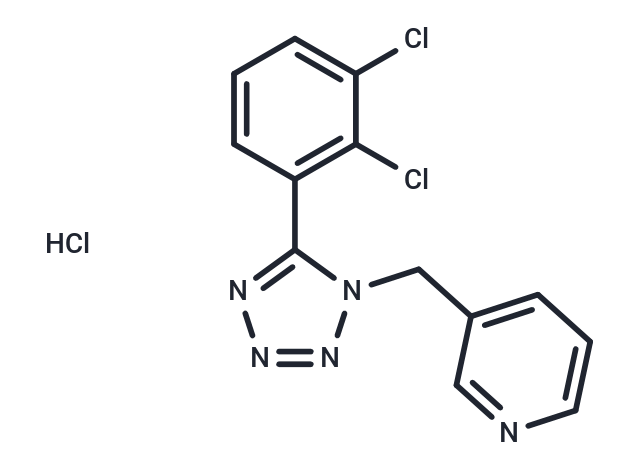Shopping Cart
- Remove All
 Your shopping cart is currently empty
Your shopping cart is currently empty

A 438079 hydrochloride (A-438079 HCl) is a potent and selective P2X7 receptor antagonist with pIC50 of 6.9.

| Pack Size | Price | Availability | Quantity |
|---|---|---|---|
| 2 mg | $41 | In Stock | |
| 5 mg | $66 | In Stock | |
| 10 mg | $105 | In Stock | |
| 25 mg | $189 | In Stock | |
| 50 mg | $312 | In Stock | |
| 100 mg | $547 | In Stock | |
| 1 mL x 10 mM (in DMSO) | $116 | In Stock |
| Description | A 438079 hydrochloride (A-438079 HCl) is a potent and selective P2X7 receptor antagonist with pIC50 of 6.9. |
| Targets&IC50 | P2X7:6.9(pIC50) |
| In vitro | A-438079 has the capability to partially, yet significantly, inhibit the depletion of striatal dopamine (DA) levels induced by 6-OHDA. Pretreatment with A-438079 reduces the pain behavior index in the HC model. Intraperitoneal injection of A-438079 (5 and 15 mg/kg) 60 minutes post-epileptic seizure onset diminishes the severity of epileptic episodes and neuronal death within the hippocampus. Additionally, intravenous administration of 80 μMol/kg A-438079 in a neuropathic rat model significantly reduces both noxious and innocuous evoked activities in various categories of spinal neurons. |
| In vivo | A-438079 demonstrates selectivity towards the P2X7 receptor at concentrations of up to 100 μM. It effectively inhibits changes in intracellular calcium concentration induced by 10 μM BzATP in 1321N1 cells stably expressing the rat P2X7 receptor, with an IC50 of 321 nM. |
| Kinase Assay | Human astrocytoma cells, 1321N1, are grown to stably express rat P2X7, human P2X4, P2X2a, P2X2/3, P2X1, P2Y1?and P2Y2 recombinant receptors. Agonist, BzATP, 2,3-O-(4-ben-zoylbenzoyl)-ATP or ATP-induced changes in intracellular Ca2+?concentrations are assessed in all of the cell lines using the Ca2+?chelating dye, Fluo-4, in conjunction with a Fluorometric Imaging Plate Reader. The cells are plated out the day before the experiment onto poly-D-lysine-coated black 96 well plates. After the agonist addition, changes in intracellular Ca2+ concentrations are recorded, per second, for 3 min. Ligands are tested at 11 half-log concentrations from 10-10 to 10-4 M. BzATP or ATP concentrations corresponds to the EC70?values for each receptor to enable comparison of antagonist potencies across the multiple P2 receptor subtypes. A 438079 is added to the cell plate and ?uorescence data are collected for 3 min before the addition of agonist, subsequently, data are then collected for another 2 min. The pEC50 or pIC50 values are derived from a single curve ?t. |
| Alias | A-438079 hydrochloride, A-438079 HCl, A 438079 (hydrochloride) |
| Molecular Weight | 342.61 |
| Formula | C13H10Cl3N5 |
| Cas No. | 899431-18-6 |
| Smiles | Cl.Clc1cccc(-c2nnnn2Cc2cccnc2)c1Cl |
| Relative Density. | no data available |
| Storage | Powder: -20°C for 3 years | In solvent: -80°C for 1 year | Shipping with blue ice. | ||||||||||||||||||||||||||||||||||||||||
| Solubility Information | H2O: 1.7 mg/mL (5 mM)), Heating is recommended. DMSO: 34.3 mg/mL (100 mM) | ||||||||||||||||||||||||||||||||||||||||
Solution Preparation Table | |||||||||||||||||||||||||||||||||||||||||
H2O/DMSO
DMSO
| |||||||||||||||||||||||||||||||||||||||||

Copyright © 2015-2024 TargetMol Chemicals Inc. All Rights Reserved.